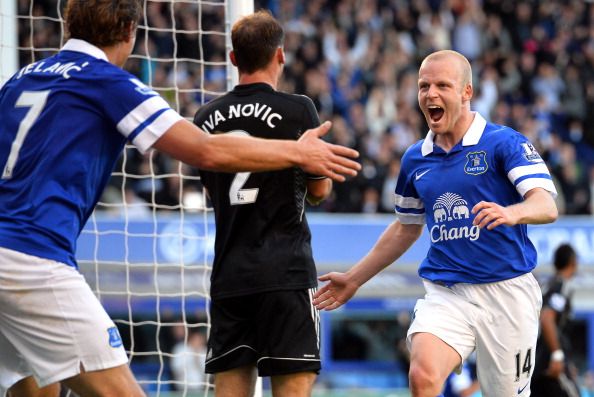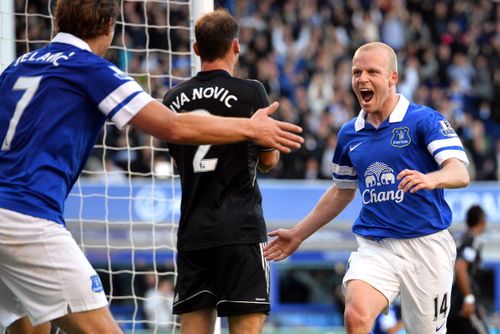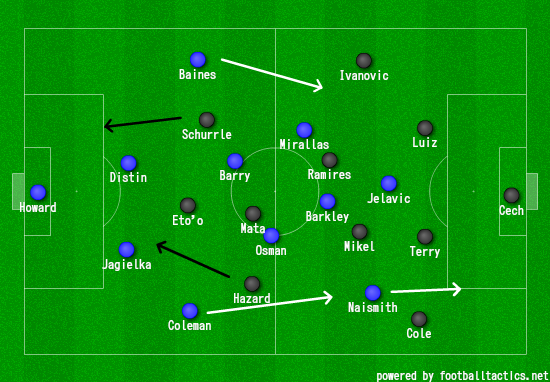
Everton 1-0 Chelsea: Tactical Analysis
Everton 1-0 Chelsea In the past few seasons, Everton have had the upper hand over Chelsea, especially when the London club have visited Merseyside. Ancelotti was sacked right after the game back in 2011 and AVB only a few weeks after the defeat to Everton.
On their last visit though, ‘The Interim One’, Benitez, guided the Blues to victory, but no such result awaited Jose Mourinho today.

Everton’s Scottish forward Steven Naismith (R) celebrates scoring the opening goal with teammate Everton’s Croatian striker Nikica Jelavic (L) during the English Premier League football match between Everton and Chelsea at Goodison Park in Liverpool, northwest England on September 14, 2013. (PAUL ELLIS/AFP/Getty Images)
Everton were looking for their first win of the season, and their first win under new manager Roberto Martinez. The Toffees have had a mixed start to the season, with 3 draws coming from their first three games. The defence has looked a bit shaky, and the finishing also needed some fine tuning, but the midfield was doing very well, with Everton being the side with the highest average ball possession in the league coming into the game.
Chelsea are still searching for their first win away from home this season. It was going to be no easy task, as this was an Everton side that hadn’t conceded at Goodison for almost 10 hours, and had lost only one home game last season – to Chelsea. A win would have taken Chelsea to the top of the rudimentary table, but it was not to be.
Both sides lined up with very similar shapes. The 4-2-3-1, which has become the standard, was employed by both managers, but slightly differently. Everton brought Barry into the side to replace Fellaini in the centre of the park. Steven Naismith celebrated his 27th birthday by starting (and eventually scoring the winning goal) in place of the injured Steven Pienaar.
Chelsea handed a debut to legendary African striker Samuel Eto’o, ahead of Fernando Torres. Juan Mata started in the ‘Number 10? role, with Hazard and Schurrle flanking him. David Luiz returned to the starting 11. Mikel was chosen to accompany Ramires in central midfield.

Everton Shapes
Many teams that follow the ‘Barcelona Philosophy’ tend to leave three men at the back while going forward. Everton under Martinez have been no different. However, there is a tweak in their system that helps them to utilise wing play and the aerial threat that Nikica Jelavic poses.
When one of the full backs gets forward, the other full back stays deep, making up three in defence. The central midfielder usually pushes back in such a system, but with Martinez opting to utilise width and crosses, the presence of central midfielders just outside the opposition box is an important factor. That’s why the full back is used to cover, as opposed to a deep lying central midfielder.
Another feature that allowed Everton to attack with width, especially through Coleman, was that both their wide forwards were playing narrow. Barkley, Jelavic, Mirallas and Naismith played in a diamond, with the aim being to provide more bodies at the end of crosses, as well as get people around Jelavic for him to flick the ball to.
Off the ball though, it was a different story. In what was a Moyes-ish defensive performance, The Toffees shifted into a 4-4-1-1 when Chelsea got the ball. The midfielders worked incredibly hard in order to close down the Chelsea midfield, with Osman being a stand-out performer (6 tackles, 4 interceptions). Gareth Barry too, did fantastically well to continuously break Chelsea’s rhythm with a number of niggling fouls. The Englishman committed 5 fouls, and managed to get through the game without picking up a yellow card.